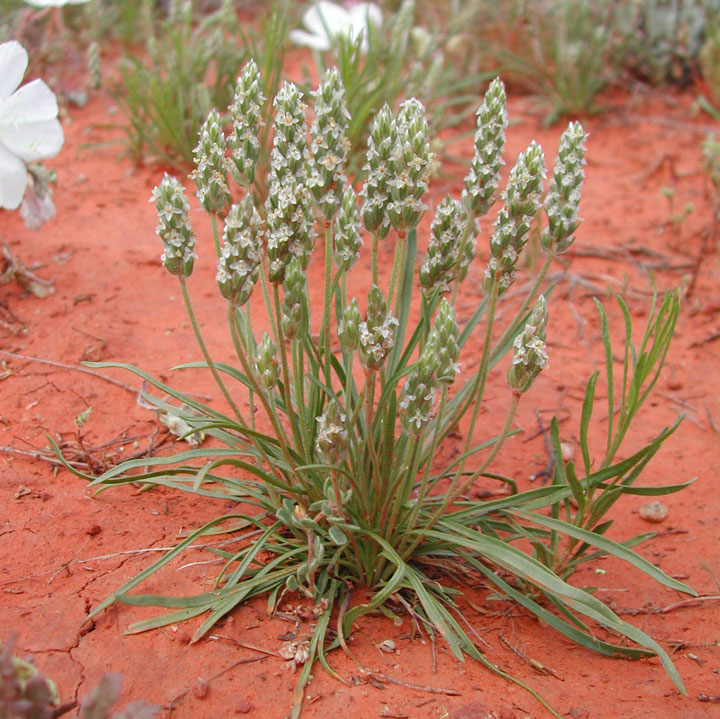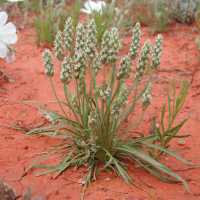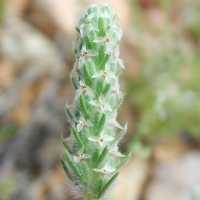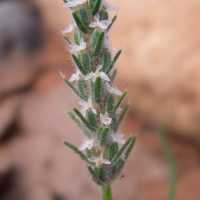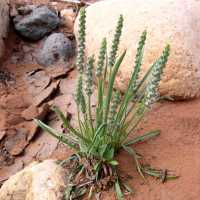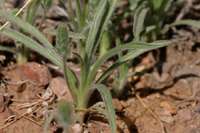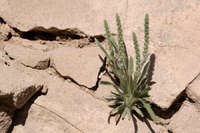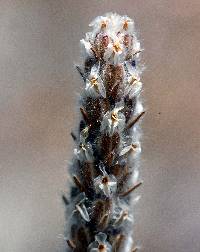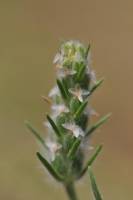Plant: Annual herb; to 21 cm tall
Leaves: without distinct petiole; blades linear to linear-lanceolate, 1-15 cm long, 0.1-0.7 cm wide, acute to acuminate at apex, sparsely to densely villous, distinctly 3-veined below, the margins entire
INFLORESCENCE: pedunculate, scapose; PEDUNCLES 2-22 cm long, hirsute, with most hairs appressed-ascending. SPIKES 1-13 cm long; bracts linear-triangular to subulate, 2-16 mm long, longer than sepals, scarious-margined at base or to near middle, sparsely to densely villous, with tufts of white hairs in axils, with midvein long ciliate
Flowers: perfect; sepals obovate, 2-5 mm long, broadly scarious-margined, villous; corolla lobes spreading or reflexed, broadly ovate, 1.2-2.5 mm long; stamens 4
Fruit: capsules, breaking at or slightly below middle; SEEDS 2, ca. 2.2 mm long, ca. 1.2 mm wide, reddish-brown to light brown to dark brown (rarely black), the inner surface concave, the outer surface rounded and alveolate
Misc: Deserts and desert grasslands; 400-2100 m (1200-6800 ft.); Feb to Jul
References: Huisinga, Kristin D. and Tina J. Ayers. 1999. Plantaginaceae. Ariz. - Nev. Acad. Sci. 32(1).
Annual herb with a taproot flowering stem to 20 cm tall
Leaves: basal, semi-clasping, to 18 cm long and 1 cm wide, linear to thread-like with a tapering base and pointed tip, more or less parallel-veined, white woolly.
Inflorescence: a dense, slender, cylindrical spike of many flowers arising from a leafless stalk (scape), 0.5 - 15 cm long, very white woolly, with bracts that are barely, if at all, projecting.
Flowers: stalkless or nearly stalkless, whitish, rust-colored at the base of each lobe, subtended by bracts that are about 5 mm long. Stamens four, exserted, alternate with corolla lobes. Style one.
Sepals: four, green, narrowly oblong egg-shaped with a rounded apex, front two green, to 3 mm long, densely hairy, minutely scarious-margined (dry, thin, and membranous), rear two mostly scarious with a green midrib.
Fruit: a dehiscent capsule (circumscissile). Seeds two, brown, 2 - 3 mm long, oblong, convex on one side, concave on the other.
Corolla: four-lobed, whitish, rust-colored at the base of each lobe, 3 - 4 mm wide, scarious (dry, thin, membranous). Lobes spreading, about 2 mm wide, rounded to egg-shaped.
Similar species: The woolly herbage, linear leaves, and short inflorescence bracts help distinguish this species.
Flowering: late May to mid July
Habitat and ecology: Introduced from farther west. Locally frequent in sandy soils. It also occurs in newly disturbed sand and along roads.
Occurence in the Chicago region: non-native
Etymology: Plantago comes from the Latin word planta, meaning footprint. Patagonica means "of or from Patagonia, Argentina."
Author: The Morton Arboretum
This species grows in very sandy soil in pastures and fallow fields. I found acres of it in a fallow, sandy field in Starke County. [Plantago pusilla, now considered a synonym of P. patagonica,] prefers slightly acid and dry soil and is generally found in pastures where it is often frequent to common. Scott's report for the Leesburg swamp in Kosciusko County should be referred to some other species.
Duration: Annual
Nativity: Native
Lifeform: Forb/Herb
General: Annual herb, 5-20 cm tall, from a slender taproot; stems erect and leafless, terminating in a dense spike of flowers; herbage woolly throughout.
Leaves: In a grass-like basal tuft; blades linear to narrowly oblanceolate, 1-15 cm long and 1-7 mm wide, narrowing gradually toward the base of the leaf; leaf margins entire; leaf surfaces covered with shaggy hairs.
Flowers: Green and white, in dense cylindrical spikes 1-13 cm long, at the tops of the leafless stems; each flower subtended by a green linear-triangular bract a little shorter than the flower but longer than the sepals, with narrow scarious margins near the base; petals 5 per flower, 2 mm long, transluscent-white, suborbicular to ovate, radiating outward from the top of the ovary.
Fruits: Capsule ellipsoid, 3.5 mm long; splitting in half like the lid off a pot (circumscissile) to release 2 brown to red-brown seeds, these 2 mm long.
Ecology: Found in dry open places, below 7,000 ft (2134 m); flowers February-July.
Distribution: Throughout N. Amer., in every state in the U.S. except MS, AL, FL, KY, PA, NH; south to S. Amer.
Notes: This incredibly common winter/spring annual is characterized by having a basal cluster of hairy, grass-like linear leaves, and leafless stems topped with a dense spike of white and green flowers. It is similar to the also incredibly common P. ovata, but that species has a shorter flower spike, less than 6 cm long; each flower is subtended by a short ovate bract, 2-3 mm long; and the hairs on the upper portion of the stems stick out at right angles (P. patagonica has flower spikes up to 21 cm long; each flower is subtended by a longer linear-triangular bract, 2-16 mm long; and the hairs on the upper stems are appressed against the stem.) This species can cover the desert floor in the late winter, and before flowering it resembles a hairy annual grass.
Ethnobotany: Keres, Navajo, and Zuni make plant tea to treat diarrhea and headaches. Havasupai and many other southwest tribes utilized the seeds as a meal, hence the common name Indian Wheat.
Etymology: Plantago is from the Latin planta, sole of the foot, and -ago, similar to, alluding to the veiny leaves lying flat on the ground; patagonica means from Patagonia in South America.
Synonyms: Plantago patagonica var. breviscapa, P. patagonica var. gnaphalioides, P. patagonica var. oblonga, P. patagonica var. spinulosa, P. picta, P. purshii, P. purshii var. breviscapa, P. purshii var. oblonga, P. purshii var. picta, P. purshii var. spinulosa, P
Editor: SBuckley 2010, FSCoburn 2015, AHazelton 2017
Annual, much like no. 14 [Plantago aristata Michx.], but smaller, more strongly woolly-villous, and with the bracts seldom much over 5 mm and scarcely or not at all exserted from the spike; 2n=20. Dry prairies and plains; native in the cordilleran region and in s. S. Amer., intr. e. to Ill. and occasionally to the Atlantic states. Our plants are apparently identical with those from S. Amer., but the name var. gnaphalioides (Nutt.) A. Gray is available should a segregation prove possible. (P. purshii) Occasional plants with the lower bracts conspicuously short-exserted from the spike have been called P. patagonica var. spinulosa (Decne.) A. Gray, and may indicate introgression from P. aristata. (P. spinulosa)
Gleason, Henry A. & Cronquist, Arthur J. 1991. Manual of vascular plants of northeastern United States and adjacent Canada. lxxv + 910 pp.
©The New York Botanical Garden. All rights reserved. Used by permission.


